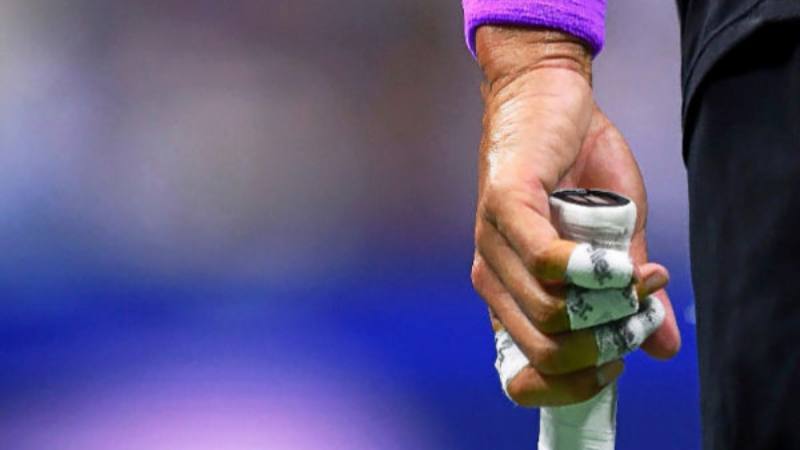
Whether you’re a seasoned pro or new to the court, tennis blisters can disrupt your game. In this guide, we explore prevention and recovery strategies to keep you in top form. From practical tips to swift recovery methods, this article is your playbook for conquering typical tennis hand blisters like thumb blisters or palm blisters. Anyway, let’s ace the game and keep those blisters at bay.
Table of Contents
5 Tips to Prevent Tennis Blisters on Hands
Tennis blisters typically develop on the hands and fingers where friction and pressure are frequent, especially on the palm, fingers, and areas in contact with the racket grip.
Proper Grip Size
Choose the right-sized grip for your tennis racket by measuring from your ring finger to the palm’s second crease, check out the step-by-step guide on measuring your grip size. A proper fit minimizes pressure and reduces blister risks.
Fresh Overgrip Every Time You Play
Replace your overgrip before each game or practice session to maintain tackiness. This small investment ensures a secure hold, improves control, and minimizes the risk of developing blisters during play.
Dry Your Grip and Hands
Wipe your grip and hands with a towel during breaks to eliminate excess moisture. This quick practice reduces friction, decreasing the chances of developing blisters. Pay extra attention to your grip hand for consistent dryness.
Wear a Sweatband on Your Forearm
Use a quality sweatband on your forearm to absorb sweat and prevent it from reaching your hand. This proactive measure significantly reduces the chances of developing blisters due to excess moisture, ensuring a confident and comfortable game.
Hand Care
Keep your hands moisturized to reduce friction-related injuries. Use protective padding or blister prevention products on hotspots. Smooth calluses with a pumice stone to prevent them from causing friction. Proactive hand care minimizes blister risks and enhances your overall playing experience.
How to Play with Tennis Blisters
Tennis blisters are a common experience for both newcomers and seasoned players. It’s essential to know how to manage them during play. Here are some items that might help minimize discomfort on the court. In general, finger tape is the go-to solution for thumb or finger blisters.
Finger Tape
Opt for durable, adhesive sports tape to address tennis blisters. Apply it directly on blisters or areas prone to friction, creating a protective layer. This quick fix offers additional support, maintaining a comfortable grip and allowing you to continue playing without worsening existing blisters or creating new ones. You can check out these finger tapes for your tennis game.
Anti-Chafe Balm
For blister relief, use the anti-chafe balm on areas prone to friction, like between fingers and the palm. Look for a long-lasting, water-resistant formula for effectiveness. This balm not only prevents blisters but also soothes existing ones, providing comfort and confidence during play. Keep it in your bag as a portable solution for blister troubles.
Wear Gloves
When dealing with tennis blisters, wearing sports gloves provides a protective layer, reducing friction between your hand and the racket grip. Choose lightweight, breathable gloves with a snug fit for comfort and control. They shield existing blisters and prevent new ones during gameplay, letting you focus on performance without discomfort.
How to Treat Tennis Blisters
Please note that everyone’s healing process may vary, so monitor the blister and adjust your approach accordingly. If there are signs of infection or prolonged discomfort, seek medical attention.
Keep the Area Clean
To recover from tennis blisters, keep the affected area clean. Gently wash it with mild soap and lukewarm water, avoiding hot water. Pat it dry with a clean towel.
Avoid Popping
Resist popping tennis blisters, as they increase infection risk and slow healing. The blister acts as a natural barrier, preventing bacteria entry. If it’s large or painful, consult a professional for draining. Keep it covered with a sterile bandage to shield it from friction and infection, allowing it to heal naturally.
Rest and Allow Healing
Give your hands time to heal by minimizing activities that worsen blisters. Rest is crucial; avoid the activities that caused the blisters. Let blisters heal naturally, allowing the skin to regenerate. Gradually resume normal activities once the blisters have fully healed.
Primary Causes of Getting Tennis Blisters
Primary factors that cause tennis blisters are when the skin undergoes persistent pressure and friction, whether from the racket grip or skin-to-skin contact. Repetitive swings in tennis create friction between the palm and racket, resulting in blister formation.
Typically blisters afflict both new and seasoned players due to adaptation challenges and repetitive swings. Despite callus formation in veterans, ongoing friction, exacerbated by sweat, remains a persistent issue, particularly between the palm and racket grip.
Conclusion
This guide offers a comprehensive playbook for tackling tennis blisters. From selecting the right grip size and using fresh overgrips to keeping hands dry and employing protective gear like gloves and sweatbands, these tips ensure an uninterrupted and enjoyable game.
